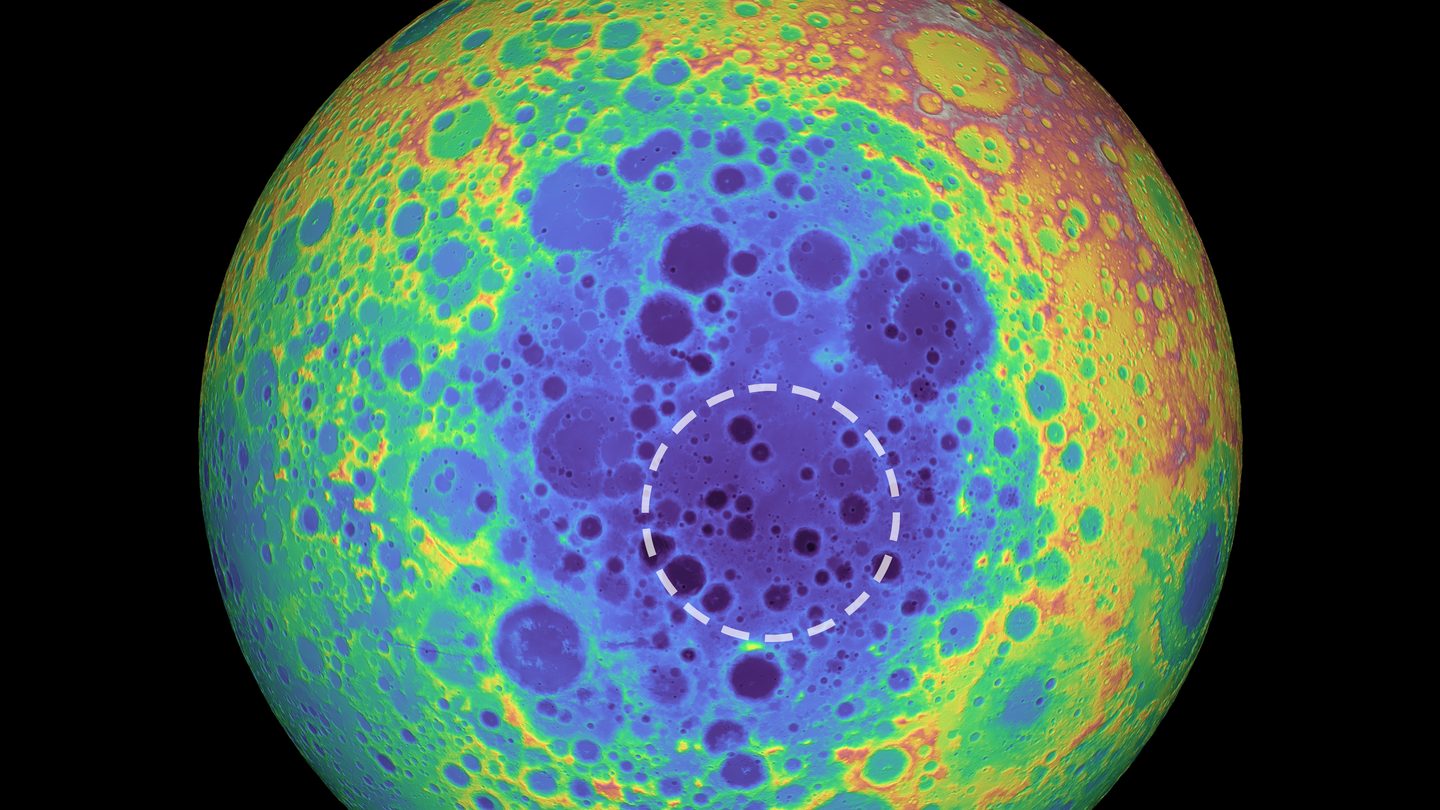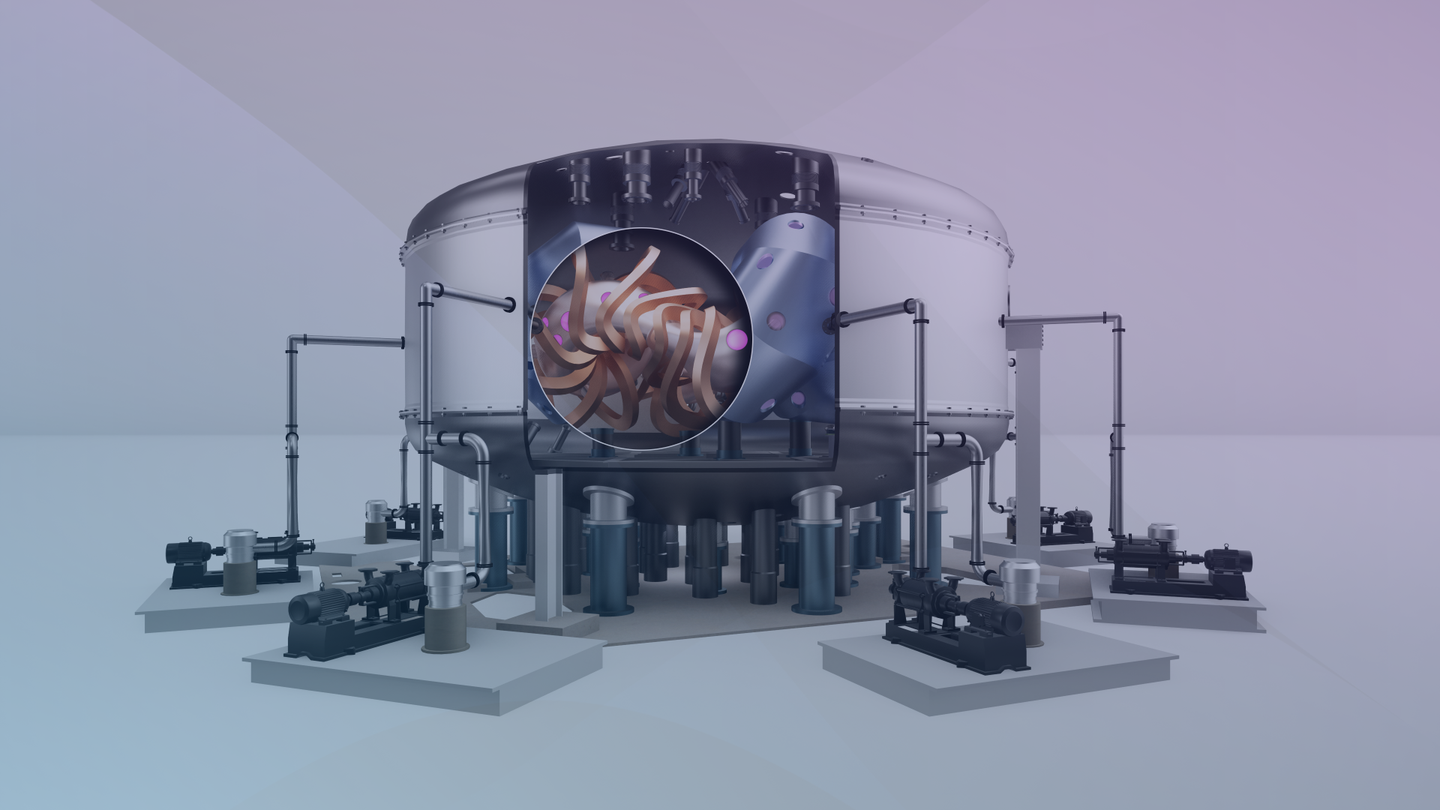A mysterious large mass has been discovered beneath the largest crater on the moon
A recent study has unearthed a substantial anomaly lurking beneath the Moon’s South Pole-Aitken basin’s floor

This false-color graphic shows the topography of the far side of the Moon. The warmer colors indicate high topography and the bluer colors indicate low topography. The South Pole-Aitken (SPA) basin is shown by the shades of blue. The dashed circle shows the location of the mass anomaly under the basin. (CREDIT: NASA/Goddard Space Flight Center/University of Arizona)
The Moon's far side holds a colossal mystery – the South Pole-Aitken basin, the largest known impact crater in our solar system. Estimated to be 4 billion years old, this titanic scar on the lunar surface stretches an astounding 2,500 kilometers (1,600 miles) in diameter, dwarfing even the distance between Waco, Texas, and Washington, D.C. But the basin's secrets extend far beyond its awe-inspiring dimensions.
A recent study by researchers at Baylor University has unearthed a substantial anomaly lurking beneath the basin's floor, hinting at the potential presence of metallic debris from the cataclysmic impact that birthed this lunar behemoth.
The research, published in the journal Geophysical Research Letters under the title "Deep Structure of the Lunar South Pole-Aitken Basin," employed data gathered by NASA's Gravity Recovery and Interior Laboratory (GRAIL) mission. By meticulously analyzing subtle variations in the Moon's gravitational field, the researchers were able to map the basin's subsurface mass distribution.
"We essentially weighed the South Pole-Aitken basin with exquisite precision," explained lead author Dr. Peter James, Assistant Professor of Planetary Geophysics at Baylor's College of Arts & Sciences. "The analysis, when combined with lunar topography data from the Lunar Reconnaissance Orbiter, revealed a surprisingly large amount of mass hundreds of kilometers below the basin's surface."
This unexpected mass, according to Dr. James, exerts a significant gravitational pull, depressing the basin floor by over 800 meters (half a mile). Two primary explanations emerge for this anomaly.
The first theory proposes that the immense impact that carved the South Pole-Aitken basin may have embedded the metallic core of the impacting asteroid deep within the Moon's mantle, the layer between the lunar crust and core.
Related Stories
"Imagine taking a colossal pile of metal, five times the size of Hawaii's Big Island, and burying it underground," Dr. James said, emphasizing the sheer scale of the potential metallic deposit. "That's roughly the magnitude of the mass anomaly we've detected."
Computer simulations of large asteroid impacts support this theory. Under specific circumstances, the simulations suggest that the iron-nickel core of an impacting asteroid could be ejected and dispersed within the Moon's upper mantle upon impact, rather than sinking directly to the core.
"Through detailed calculations, we were able to demonstrate that a sufficiently dispersed core from the impacting asteroid could plausibly remain suspended in the mantle to this day, instead of succumbing to the pull of the Moon's core," Dr. James elaborated.
The alternative explanation for the anomaly centers on the Moon's own geological history. It is possible that the mass anomaly represents a dense concentration of oxides, potentially remnants left behind during the final solidification stages of the Moon's ancient magma ocean, a period when the Moon was entirely molten.
The South Pole-Aitken basin presents a unique opportunity for researchers to delve into the violent impact history of our solar system's rocky bodies.
"This basin serves as an exceptional natural laboratory for studying these catastrophic impact events," Dr. James remarked. "These ancient impacts played a crucial role in shaping the rocky planets and moons we see around us today, and the South Pole-Aitken basin offers a window into that formative period."
The immense size and depth of the basin expose layers of the Moon's mantle that would otherwise be inaccessible for direct study. Furthermore, the potential presence of the asteroid's metallic core, if confirmed, would provide invaluable insights into the composition of asteroids that bombarded the early Solar System.
Future lunar missions hold the key to unlocking the secrets buried beneath the South Pole-Aitken basin. Direct analysis of lunar samples, particularly those retrieved from the basin's floor, could shed light on the composition of the anomalous mass. Additionally, more sophisticated geophysical surveys planned for future missions could provide a clearer picture of the mass distribution within the basin.
The South Pole-Aitken basin, with its hidden anomaly, stands as a testament to the Moon's violent past and offers a glimpse into the formation of our solar system. As we delve deeper into this lunar enigma, we gain a greater understanding of the forces that shaped not only our Moon but also the rocky worlds that surround us.
Ten interesting facts about the Moon:
The Moon is not the biggest moon in the solar system, but compared to the size of the planet it orbits, it's the largest.
The Moon is pretty dense, but not the densest. Jupiter's moon, Io, takes that crown, at least among the ones we know about.
The Moon always shows the same face to Earth because it's stuck in a synchronized spin with us. One side is smooth and dark, thanks to volcanic activity, while the other side is bumpy with lots of craters.
The Moon's surface is darker than you might think. Even though it looks bright in our night sky, it's actually not much brighter than old, worn-out asphalt. Its gravity is responsible for our ocean tides and even stretches out our days a tiny bit.
The Sun and the Moon might look similar in size from here, but that's just a trick of perspective. The Moon is way smaller than the Sun, but it's also much closer to us, making them seem about the same size.
The Moon is slowly moving away from us, about the width of a thumb every year.
Scientists think the Moon was formed when a huge rock crashed into Earth billions of years ago, back when the solar system was just getting started.
Besides causing ocean tides, the Moon also makes solid ground on Earth bulge and shrink slightly as it orbits us. It's not as noticeable as the tides, but it's still happening.
The Moon has its own version of earthquakes called moonquakes. They're not as strong as earthquakes and last longer because they're caused by Earth's gravity tugging on the Moon.
Believe it or not, there's water on the Moon! It's mostly ice hiding in shadowy, super-cold spots, probably brought there by comet impacts.
For more science news stories check out our New Discoveries section at The Brighter Side of News.
Note: Materials provided above by The Brighter Side of News. Content may be edited for style and length.
Like these kind of feel good stories? Get the Brighter Side of News' newsletter.
Joshua Shavit
Science & Technology Writer | AI and Robotics Reporter
Joshua Shavit is a Los Angeles-based science and technology writer with a passion for exploring the breakthroughs shaping the future. As a contributor to The Brighter Side of News, he focuses on positive and transformative advancements in AI, technology, physics, engineering, robotics and space science. Joshua is currently working towards a Bachelor of Science in Business Administration at the University of California, Berkeley. He combines his academic background with a talent for storytelling, making complex scientific discoveries engaging and accessible. His work highlights the innovators behind the ideas, bringing readers closer to the people driving progress.



